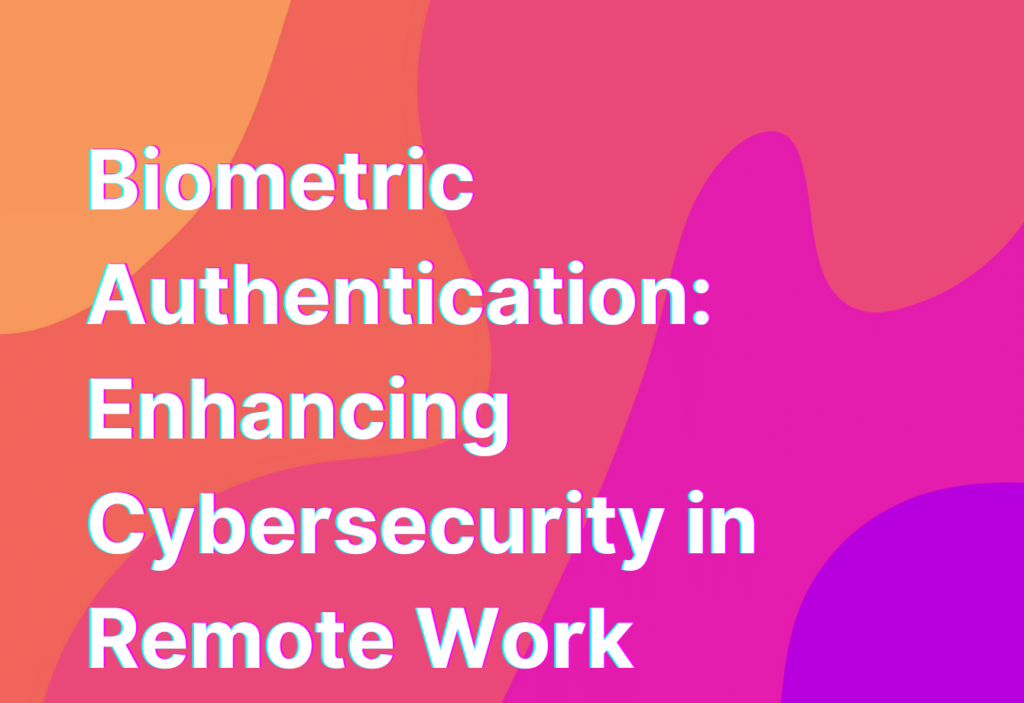Biometric Authentication: Enhancing Cybersecurity in Remote Work
Hey there, remote work enthusiasts! It’s Ashley here, your friendly remote work advocate with another informative blog post. Today, we’re diving into the world of biometric authentication and how it can enhance cybersecurity in remote work. So grab your favorite cup of coffee and let’s get started!
What is Biometric Authentication?
Biometric authentication is a fancy term for using unique physical or behavioral characteristics to verify a person’s identity. Instead of relying on traditional passwords or PINs, biometric authentication uses things like fingerprints, facial recognition, voice patterns, or even iris scans to grant access to systems or devices. It’s like something straight out of a sci-fi movie, but it’s becoming increasingly common in our digital world.
Now, you might be wondering, “Why should I care about biometric authentication in remote work?” Well, my friend, let me tell you!
The Benefits of Biometric Authentication in Remote Work
1. Enhanced Security: Biometric authentication adds an extra layer of security to your remote work setup. Unlike passwords that can be easily guessed or stolen, your unique biometric features are much harder to replicate. It’s like having a digital bodyguard protecting your sensitive data.
2. Convenience: Let’s face it, remembering passwords can be a pain. With biometric authentication, you don’t have to worry about forgetting your password or fumbling with multiple login credentials. Just a quick scan or touch, and you’re in!
3. Time-Saving: In the fast-paced world of remote work, every second counts. Biometric authentication eliminates the need for lengthy login processes, saving you precious time that can be better spent on important tasks.
4. Reduced Fraud: Traditional authentication methods like passwords or PINs can be easily stolen or hacked. Biometric authentication, on the other hand, makes it incredibly difficult for fraudsters to impersonate you. It’s like having a virtual bouncer at the door, keeping the bad guys out.
5. Improved User Experience: Biometric authentication offers a seamless and user-friendly experience. No more struggling to remember complex passwords or dealing with frustrating login issues. It’s a win-win for both security and convenience.
Popular Biometric Authentication Methods
Now that we’ve covered the benefits, let’s take a look at some popular biometric authentication methods that are commonly used in remote work:
- Fingerprint Scanners: These tiny sensors capture the unique patterns on your fingertips, making it one of the most widely used biometric authentication methods. Just a touch, and you’re in!
- Facial Recognition: Your face is like a digital key that unlocks your devices or systems. Facial recognition technology analyzes the unique features of your face to grant access.
- Voice Recognition: Your voice is as unique as your fingerprint. Voice recognition technology uses your vocal patterns to verify your identity.
- Iris Scanners: This futuristic technology scans the patterns in your iris to authenticate your identity. It’s like something straight out of a spy movie!
- Behavioral Biometrics: This method analyzes your unique behavioral patterns, such as typing speed or mouse movements, to verify your identity. It’s like having a digital fingerprint of your actions.
These are just a few examples of the many biometric authentication methods available today. The technology is constantly evolving, and who knows what exciting advancements we’ll see in the future!
Implementing Biometric Authentication in Remote Work
Now that you’re convinced of the benefits of biometric authentication, you might be wondering how to implement it in your remote work setup. Here are a few tips to get you started:
- Research and choose the right biometric authentication method for your needs. Consider factors like security, compatibility with your devices, and ease of use.
- Ensure that the biometric authentication system you choose is compatible with your existing remote work tools and software. Integration is key!
- Train your remote team on how to use the biometric authentication system effectively. Provide clear instructions and support to ensure a smooth transition.
- Regularly update and maintain your biometric authentication system to stay ahead of potential security vulnerabilities.
- Don’t forget to educate your remote team about the importance of cybersecurity hygiene. For more tips on this topic, check out this Cybersecurity hygiene guide.
By following these steps, you’ll be well on your way to enhancing the cybersecurity of your remote work setup with biometric authentication.
Wrapping Up
And there you have it, folks! Biometric authentication is a powerful tool that can greatly enhance the cybersecurity of your remote work environment. With its enhanced security, convenience, and time-saving benefits, it’s no wonder why more and more companies are adopting this technology.
So, whether you’re using fingerprint scanners, facial recognition, or even behavioral biometrics, biometric authentication is a game-changer in the world of remote work. Embrace the future, protect your data, and enjoy the seamless user experience it offers.
Stay secure, stay remote, and until next time!


